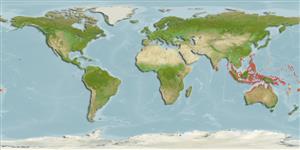>
Ovalentaria/misc (Various families in series Ovalentaria) >
Ambassidae (Asiatic glassfishes)
Etymology: Ambassis: Derived from Greek, anabasis = climbing up (Ref. 45335).
More on author: Günther.
Environment: milieu / climate zone / depth range / distribution range
Ecología
marino; agua dulce; salobre demersal; anfidromo (Ref. 51243); rango de profundidad 0 - 2 m (Ref. 86942). Tropical; 26°N - 27°S, 75°E - 172°W
Indo-Pacific: Arabian Sea and India, to Indonesia, Malaysia, East Timor, Taiwan, southern Japan, northern Australia, New Guinea, New Caledonia, Fiji, Samoa and the Cook Is.
Tamaño / Peso / Age
Maturity: Lm ? range ? - ? cm
Max length : 10.3 cm TL macho / no sexado; (Ref. 7050)
Espinas dorsales (total) : 8; Radios blandos dorsales (total) : 9 - 10; Espinas anales: 3; Radios blandos anales: 9 - 10. Resembles A. urotaenia, but differs in having large eye, and a gently-rounded snout. Eye diameter over 30% and interorbital width over 20% of head length. Cheek scales in 2 rows. Attains 8 cm TL.
Inhabits clear, flowing creeks, usually within 20 kilometers of the sea (Ref. 44894). Commonly found in brackish waters and river mouths. Occurs near mangroves, stagnant and running freshwater (Ref. 7300) and coastal areas (Ref. 45255). This species has a marine larval stage, judging from its broad distribution. One of the best viewing areas is at the Freshwater creek picnic ground in Cairns, where individuals frequently aggregate along the vegetated stream margin (Ref. 44894).
Life cycle and mating behavior
Maturities | Reproducción | Spawnings | Egg(s) | Fecundities | Larva
Paxton, J.R., D.F. Hoese, G.R. Allen and J.E. Hanley, 1989. Pisces. Petromyzontidae to Carangidae. Zoological Catalogue of Australia, Vol. 7. Australian Government Publishing Service, Canberra, 665 p. (Ref. 7300)
IUCN Red List Status (Ref. 130435)
Threat to humans
Harmless
Human uses
Herramientas
Special reports
Download XML
Fuentes de Internet
Estimates based on models
Preferred temperature (Ref.
123201): 26.2 - 29.3, mean 28.7 °C (based on 1629 cells).
Phylogenetic diversity index (Ref.
82804): PD
50 = 0.5000 [Uniqueness, from 0.5 = low to 2.0 = high].
Bayesian length-weight: a=0.01230 (0.00515 - 0.02940), b=3.01 (2.82 - 3.20), in cm total length, based on LWR estimates for this Genus-body shape (Ref.
93245).
Nivel trófico (Ref.
69278): 3.5 ±0.41 se; based on food items.
Resiliencia (Ref.
120179): Alto, población duplicada en un tiempo mínimo inferior a 15 meses (Assuming Fec > 10,000).
Fishing Vulnerability (Ref.
59153): Low vulnerability (10 of 100).
